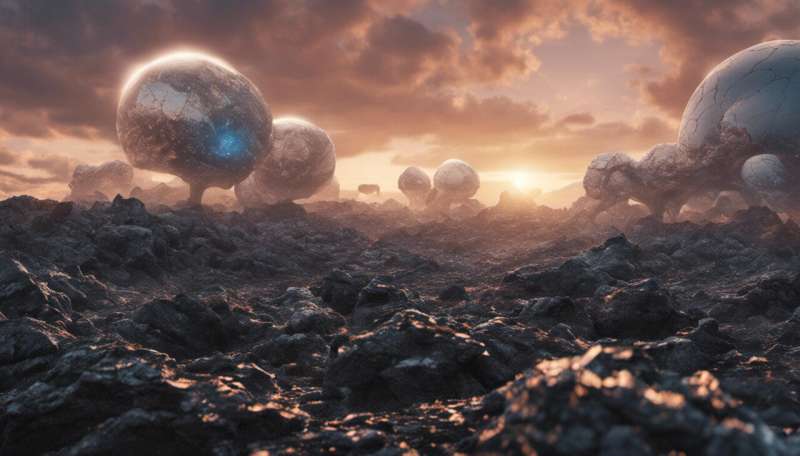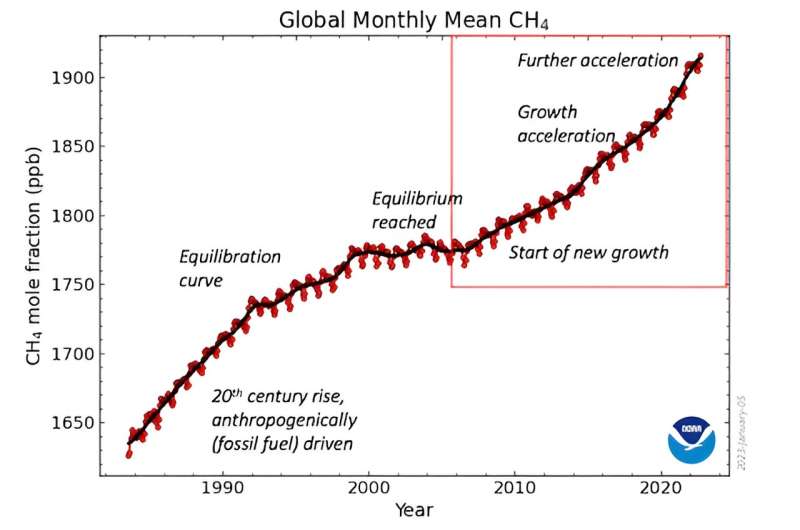Rising methane could be a sign that Earth's climate is part way through a 'termination-level transition'

Since 2006, the amount of heat-trapping methane in Earth's atmosphere has been rising fast and, unlike the rise in carbon dioxide (CO₂), methane's recent increase seems to be driven by biological emissions, not the burning of fossil fuels. This might just be ordinary variability—a result of natural climate cycles such as El Niño. Or it may signal that a great transition in Earth's climate has begun.
Molecule for molecule, methane is a much more potent greenhouse gas than CO₂ but it lasts slightly less than a decade in the atmosphere compared with centuries for CO₂. Methane emissions threaten humanity's ability to limit warming to relatively safe levels. Even more troubling, the rate at which methane is increasing in the atmosphere has accelerated recently. Something like this has happened before: sudden surges in methane marked the transitions from cold ice ages to warm interglacial climates.
Methane was about 0.7 parts per million (ppm) of the air before humans began burning fossil fuels. Now it is over 1.9 ppm and rising fast. Roughly three-fifths of emissions come from fossil fuel use, farming, landfills and waste. The remainder is from natural sources, especially vegetation rotting in tropical and northern wetlands.
Methane is both a driver and a messenger of climate change. We don't know why it is now rising so rapidly, but the pattern of growth since late 2006 resembles how methane behaved during great flips in Earth's climate in the distant past.
The methane record: 2006 to present
In late 2006, atmospheric methane unexpectedly began rising. Methane had risen fast in the 19th and 20th centuries but plateaued by the end of the 1990s. This rise was driven by fossil fuel emissions, especially from gasfields and coal mines.
Imagine accelerating a car with your foot flat down. The car speeds up but eventually air resistance equals engine power and the car hits maximum speed. In 1999, it looked like methane had reached a similar equilibrium between its sources and sinks. Then in late 2006, the amount of methane in the air climbed fast. Even more unexpectedly five years later, the rate of growth sped up again. During the 2020s the growth rate has become yet faster, faster even than during the peak of gas industry leaks in the 1980s.
Today's growth seems to be driven by new emissions from wetlands, especially near the equator but perhaps also from Canada (beavers are methane factories which pull huge amounts of plant matter into ponds they've made) and Siberia. This is a result of climate change: increasing rainfall has made wetlands wetter and bigger while rising temperatures have boosted plant growth, providing more decomposing matter and so more methane. Emissions from huge cattle lots in tropical Africa, India and Brazil may also be rising and rotting waste in landfills near megacities like Delhi are important sources too.

Climate terminations
In the past few million years, Earth's climate has flipped repeatedly between long, cold glacial periods, with ice sheets covering northern Europe and Canada, and shorter warm inter-glacials.
When each ice age ended, Earth's surface warmed by as much as several degrees centigrade over a few millennia. Recorded in air bubbles in ice cores, sharply rising methane concentrations are the bellwethers of these great climate-warming events. With each flip from a glacial to an interglacial climate there have been sudden, sharp rises in atmospheric methane, likely from expanding tropical wetlands.
These great climate flips that ended each ice age are known as terminations. Each has a Roman numeral, ranging from Termination IX which happened about 800,000 years ago to Termination IA which initiated the modern climate less than 12,000 years ago. For example, around 131,000 years ago during Termination II, the British climate suddenly flipped from glaciers in the Cotswolds to hippopotami wallowing in what is now Trafalgar Square.
Full terminations take several thousands of years to complete, but many include a creeping onset of warming, then a very abrupt phase of extremely rapid climate change that can take a century or less, followed by a longer, slower period during which the great ice caps finally melt. In the abrupt phase of the great change that brought about the modern climate, Greenland's temperature rose by around 10°C within a few decades. During these abrupt phases, methane climbs very steeply indeed.
Is something dramatic underway?
Methane fluctuated widely in pre-industrial times. But its increasingly rapid growth since 2006 is comparable with records of methane from the early years of abrupt phases of past termination events, like the one that warmed Greenland so dramatically less than 12,000 years ago.
There is already lots of evidence that the climate is shifting. Atlantic ocean currents are slowing, tropical weather regions are expanding, the far north and south are warming fast, ocean heat is breaking records and extreme weather is becoming routine.
In glacial terminations, the entire climate system reorganizes. In the past, this took Earth out of stable ice age climates and into warm inter-glacials. But we are already in a warm interglacial. What comes next is hard to imagine: loss of sea ice in the Arctic in summer, thinning or partial collapse of the ice caps in Greenland and West Antarctica, reorganization of the Atlantic's ocean currents and the poleward expansion of tropical weather circulation patterns. The consequences, both for the biosphere in general and food production in south and east Asia and parts of Africa in particular, would be very significant.
There's much to be done that could hastily stop methane's rise: plugging leaks in the oil and gas industry, covering landfills with soil, reducing crop-waste burning. Shooting the methane messenger won't stop climate change, which is primarily driven by CO₂ emissions, but it will help.
Roman numerals IX to I denote past great climate transitions. There is no Roman number zero, but then any future termination-scale transition will be different—a temperature step from our present interglacial climate to some new future that is warmer yet. Methane's signal is still unclear, but the question remains: has Termination Zero begun?
Provided by The Conversation
This article is republished from The Conversation under a Creative Commons license. Read the original article.![]() Delaying methane mitigation increases risk of breaching Paris Agreement climate goal, study finds
Delaying methane mitigation increases risk of breaching Paris Agreement climate goal, study finds
No comments:
Post a Comment